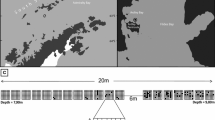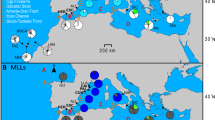Abstract
Many relevant aspects of the breeding ecology of South American migratory fishes remain obscure. We conducted kinship analyses and parental reconstruction based on microsatellite genotypes of 41 Salminus brasiliensis larvae sampled from a single natural spawning event. Polygynandry involving 25 (12:13) potential parents was suggested, supporting ecological observations of aggregation during spawning. Some parents contributed up to five half-sibling larvae genotypes, implying a skewed contribution of genes to the progeny. This study contributed to preliminary insights into the S. brasiliensis genetic mating system.
Similar content being viewed by others
References
Agostinho AA, Gomes LC, Veríssimo S, Okada EK (2004) Flood regime, dam regulation and fish in the Upper Paraná River: effects on assemblage attributes, reproduction and recruitment. Rev Fish Biol Fisher 14:11–19
Aljanabi S M, Martinez I (1997) Universal and rapid salt-extraction of high quality genomic DNA for PCR-based techniques. Nucl Acids Res 25:4692-4693
Avise JC, Fiumera AC, Jones AG, Walker D, DeWoody JA (2002) Genetic mating systems and reproductive natural histories of fishes: lessons for ecology and evolution. Annu Rev Genet 36:19–45
Coleman SW, Jones AG (2011) Patterns of multiple paternity and maternity in fishes. Biol J Linn Soc 103:735–760
de Mestral LG, Herbinger CM, O’Reilly PT (2012) Mating structure of an endangered population of wild Atlantic salmon (Salmo salar) as determined using sibship reconstruction and a novel method of sex inference. Can J Fish Aquat Sci 69:1352–1361
Emery AM, Wilson IJ, Craig S, Boyle PR, Noble LR (2001) Assignment of paternity groups without access to parental genotypes: multiple mating and developmental plasticity in squid. Mol Ecol 10:1265–1278
Godinho AL, Lamas IR, Godinho HP (2010) Reproductive ecology of Brazilian freshwater fishes. Environ Biol Fish 87:143–162
Herbinger CM, O’reilly PT, Verspoor E (2006) Unravelling first‐generation pedigrees in wild endangered salmon populations using molecular genetic markers. Mol Ecol 15:2261–2275
Hermes-Silva S, Reynalte-Tataje DA, Zaniboni-Filho E (2009) Spatial and temporal distribution of ichthyoplankton in the Upper Uruguay River, Brazil. Braz Arch Biol Techn 52:933–944
Jones OR, Wang J (2010) COLONY: a program for parentage and sibship inference from multilocus genotype data. Mol Ecol Res 3:551–555
Kanno Y, Vokoun JC, Letcher BH (2011) Sibship reconstruction for inferring mating systems, dispersal and effective population size in headwater brook trout (Salvelinus fontinalis) populations. Conserv Genet 12:619–628
Lowe-McConnell RH (1999) Estudos ecológicos de comunidades de peixes tropicais. EDUSP, São Paulo
Nakatani K, Agostinho AA, Baumgartner G, Bialetzki A, Sanches PV, Makrakis MC, Pavanelli CS (2001) Ovos e larvas de peixes de água doce: desenvolvimento e manual de identificação. EDUEM, Maringá
Peakall R, Smouse PE (2012) GenAlEx 6.5: genetic analysis in Excel. Population genetic software for teaching and research–an update. Bioinformatics 28:2537–2539
Plesnar-Bielak A, Skrzynecka AM, Prokop ZM, Radwan J (2013) Mating system affects population performance and extinction risk under environmental challenge. Proc R Soc London A 279:4661–4667
Queller DC, Goodnight KF (1989) Estimating relatedness using genetic markers. Evolution 43:258–275
Raymond M, Rousset F (1995) GENEPOP (version 1.2): population genetics software for exact tests and ecumenicism. J Hered 86:248–249
Reynalte-Tataje DA, Nuñer APO, Nunes MC, Garcia V, Lopes CA, Zaniboni-Filho E (2012) Spawning of migratory fish species between two reservoirs of the Upper Uruguay River, Brazil. Neotrop Ichthyol 10:829–835
Reynalte-Tataje DA, Zaniboni-Filho E (2008) Biologia e identificação de ovos e larvas de peixes do alto rio Uruguai. In: Zaniboni-Filho E, Nuñer APO (eds) Reservatório de Itá. Estudos ambientais, desenvolvimento de tecnologia e conservação da ictiofauna. EDUFSC, Florianópolis, pp 229-255
Rodriguez‐Barreto D, Consuegra S, Jerez S, Cejas JR, Martín V, Lorenzo A (2013) Using molecular markers for pedigree reconstruction of the greater amberjack (Seriola dumerili) in the absence of parental information. Anim geneti 44:596–600
Rossini BC, Nunes AG, Freitas PD, Galetti PM (2011) Permanent Genetic Resources added to Molecular Ecology Resources Database 1 December 2010-31 January 2011. Mol Ecol Resour 11:586–589
Sanches A, Galetti PM (2012) Population genetic structure revealed by a school of the freshwater migratory fish, Brycon hilarii. Lat Am J Aquat Res 40:408-417
Sato Y, Godinho HP (2003) Migratory fishes of the São Francisco River. In: Carosfeld J, Harvey B, Ross C, Baer A (eds) Migratory fishes of South America: biology, fisheries and conservation status. World Fisheries Trust/The World Bank/International Development Research Centre, Ottawa, pp 195–232
Silva JV, Hilsdorf AWS (2011) Isolation and characterization of polymorphic microsatellite loci from Salminus hilarii (Characiformes: Characidae). Conserv Genet Res 3:437–439
Van Oosterhout CWF, Hutchinson D, Wills P, Shipley P (2004) MICRO-CHECKER: software for identifying and correcting genotyping errors in microsatellite data. Mol Ecol Notes 4:535–538
Vazzoler AEAM (1996) Biologia da reprodução de peixes teleósteos: teoria e prática. EDUEM, Maringá, Paraná
Wang J, Santure AW (2009) Parentage and sibship inference from multilocus genotype data under polygamy. Genetics 181:1579–1594
Xue D, Zhang T, Liu JX (2014) Microsatellite Evidence for High Frequency of Multiple Paternity in the Marine Gastropod Rapana venosa. PLoS ONE 9(1): e86508
Zaniboni-Filho E, Nuñer APO (2008) Reservatório de Itá. Estudos ambientais, desenvolvimento de tecnologias de cultivo e conservação da ictiofauna. SC: Editora da UFSC/Tractebel Energia, Florianópolis
Acknowledgments
This study was carried out under permit and guidelines of the Animal Care Protocol PP00788 of the Federal University of Santa Catarina (UFSC). We are grateful to Michele C. Nunes M. C. and Pedro Iaczinki for help collecting biological material. We deeply thank Dr. DA Reynalte-Tataje for taxonomic identification of larvae, and Carolina B. M. Silva for collaboration in molecular identification. JR thanks the support of Coordenação de Aperfeiçoamento de Pessoal de Nível Superior (CAPES) through Programa de Doutorado Sanduíche no Exterior (PDSE) (no. 1592/81-2). PMGJ thanks Fundação de Amparo à Pesquisa do Estado de São Paulo (FAPESP, Grant no. 2010/52315-7), Conselho Nacional de Desenvolvimento Científico e Tecnológico (CNPq) and Sistema Nacional de Pesquisa em Biodiversidade (SISBIOTA-Brazil, MCTI/CNPq no. 563299/2010-0). CIM is currently a fellow of Consejo Nacional de Investigaciones Científicas y Técnicas (CONICET, Argentina), and during the initial drafting of this manuscript she was supported by CAPES through a scholarship under “Programa de Apoio a Projetos Institucionais com a Participação de Recém-Doutores” (PRODOC) (2637/2010).
Author information
Authors and Affiliations
Corresponding author
Electronic supplementary material
Below is the link to the electronic supplementary material.
About this article
Cite this article
Ribolli, J., Miño, C.I., Zaniboni-Filho, E. et al. Preliminary insights into the genetic mating system of Neotropical Salminus brasiliensis: kinship assignment and parental reconstruction reveal polygynandry. Ichthyol Res 63, 187–191 (2016). https://doi.org/10.1007/s10228-015-0487-2
Received:
Revised:
Accepted:
Published:
Issue Date:
DOI: https://doi.org/10.1007/s10228-015-0487-2




